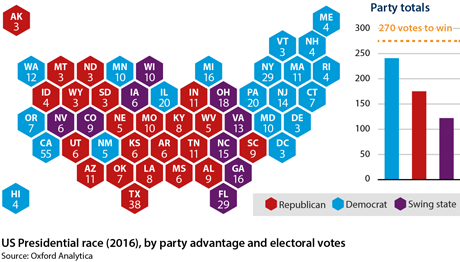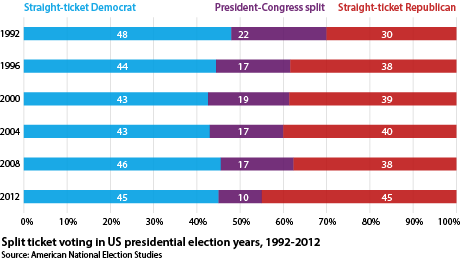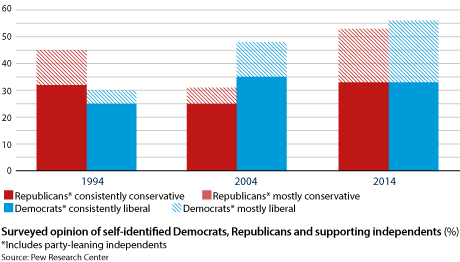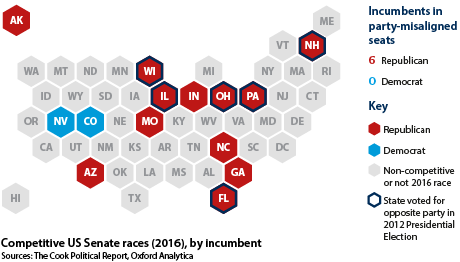Prospects for US politics to end-2016
In an election challenging conventional politics, Clinton seeks to hold together the Obama coalition
With the functional conclusion of the presidential primaries, former Secretary of State Hillary Clinton will face Donald Trump in the November 8 general election. Most policy action and political posturing by both parties in the coming months will aim to rally their ideological base and sway undecided voters.
What next
Clinton is the favourite for the US presidential election, though she will probably not receive the full Democratic Congress she seeks. However, despite the electoral map, the narrowing Republican base and Trump's lack of experience as a national political campaigner, it is possible a hitherto unknown scandal, sharp economic downturn or substantial national security crisis would merit a reassessment of this projection.
Strategic summary
- Trump's lack of organised data collection, fundraising and get-out-the-vote efforts risks negatively affecting down-ballot races.
- Senate Republicans will only move forward on Merrick Garland's Supreme Court nomination if Clinton wins the election.
- The Trans-Pacific Partnership (TPP) is unlikely to be ratified by Congress in its current form.
- The small sample size of post-1945 presidential elections will lead to misleading theoretical forecasting models.
- High voter turnout will help boost Democrats, whereas Republicans stand to benefit from depressed turnout.
Analysis
With the primaries concluded, both presumptive nominees will turn to unifying party loyalists and probing their opponents for viable areas of attack.
Post-primary Democrats
Clinton will receive a bump in the polls following her official nomination at the July 25-27 Democratic convention in Philadelphia.
While her primary opponent, Senator Bernie Sanders, is still campaigning nationally, he is likely pursuing internal changes to the Democratic Party while he still has leverage and media attention, rather than a genuine desire to scupper Clinton's candidacy (see UNITED STATES: Sanders will make exit cost Clinton - May 9, 2016).
A number of vocal Sanders supporters have insisted that they will not vote for Clinton at the general election, but significant defections to the Republicans or Donald Trump are unlikely to be forthcoming.
Although Clinton is running to succeed a two-term Democratic incumbent, Obama is less of an electoral liability to the Democrats than Bill Clinton was in 2000 or George W Bush to Republicans in 2008.
+8%
Gallup Obama net approval rating (June 10, 2016)
Obama's relatively positive net approval rating (+8% as of June 10) will enable him to be an effective surrogate on the campaign trail, particularly with Clinton-sceptical Democratic constituencies who overwhelmingly support Obama, such as young voters and consistent ideological liberals.
Post-primary Republicans
Trump's victory in the Republican primary has upset established political wisdom, given his success despite:
- lack of political experience;
- minimal campaign organisation;
- controversial rhetoric; and
- deviation from orthodox Republican policy positions (see UNITED STATES: Republicans face splits beyond Trump - March 17, 2016).
Arguments in favour of Trump's general election viability focus on his unpredictability and his purported potential to peel 'independents' and white working-class voters in the Midwestern industrial 'Rust Belt' states away from the Democrats.
However, Trump's nativist rhetoric is likely to alienate politically moderate suburbanites, women and non-white voters -- all identified by the Republican Party following its 2012 loss as key constituencies for national-level success (see UNITED STATES: Hispanics will boost Democrats in 2016 - December 18, 2015).
Aggregate state-level polling after the party conventions in July will provide a better picture of whether Trump has expanded the Republican coalition more than his primary campaign has pushed constituencies away.
Strong Trump polling in the Midwest and Pennsylvania would indicate viability
Strong polling by Trump in the politically competitive 'swing states' -- or a strong showing in reliably Democratic states like Wisconsin and Pennsylvania -- would be an early indicator of Trump's heretofore improbable viability with the 2016 electoral map (see UNITED STATES: Elections highlight analysts' failings - April 1, 2013).
However, the traditional Electoral College map favours Clinton, as she would probably only need to win two of nine swing states to reach the necessary 270 electoral votes to become president, compared to Trump's target of seven, barring a dramatic geographic realignment from 2008 and 2012.
'Independents'
However, it is important to note that most self-identified political 'independents' -- the largest US political affiliation -- often have consistently conservative or liberal views, and lean accordingly towards the same party at the ballot box.
Political 'independents' strongly backed Trump in the Republican primaries over other candidates, but these are highly unlikely to be true middle-of-the-road individuals or Obama voters in 2008 and 2012.
These party-leaning independents also have been shown to deviate little from the policy preferences of party loyalists and can functionally be classified as part of the party base.
According to 2012 data collected by American National Election Studies (ANES), Democratic-leaning independents voted overwhelmingly (88%) for Obama, similar to self-identified Democrats (92%).
Most 'independents' vote more consistently than the title would suggest
The same holds true for Republicans, with Republican-leaning independents (86%) backing Mitt Romney at similar levels to party loyalists (92%).
Only independents with weak party leanings saw double-digit voting for the opposing candidate, with 15% of slightly Democratic-leaning independents defecting, compared to 12% of slightly Republican-leaning independents.
Truly on-the-fence individuals are probably a small portion of independents and include a significant number of politically disengaged eligible voters, who will be difficult to get to turn out on Election Day.
'Sore losers'
The vitriol of the primary campaigns has led some to argue that the 'sore loser' phenomenon -- whereby primary-season opponents of the nominee sit out the general election, back a third candidate or defect to the opposition -- will significantly hinder both candidates. However, there are mitigating factors.
Clinton (37%) and Trump (53%) have the highest 'strongly unfavourable' ratings of all presidential nominees since 1980, which could see a stronger-than-usual 'sore loser' effect, though this will probably not upend the general dynamics of the race.
Factors promoting a rallying behind the nominee nevertheless include:
Greater dislike for opponents
The largest portions of both Clinton (46%) and Trump (47%) supporters have stated in surveys that they are primarily voting out of dislike for the other candidate, rather than support for their policy positions or their candidate's personal likeability.
Duverger's law
The Libertarian Party candidate, Gary Johnson, has benefitted from Clinton and Trump's unpopularity, polling at about 10% in recent polls.
However, a political science concept known as 'Duverger's law' holds that in first-past-the-post systems -- whereby the candidate with a plurality of votes wins outright -- most voters eventually go for one of the major parties.
Johnson may pull more of the popular vote this election cycle than his 0.99% in 2012, but Republican supporters are likelier candidates for defection than Democrats.
Polarisation
Democrats have become increasingly liberal and Republicans increasingly conservative, making them less likely either to cross party lines or mix their presidential and congressional preferences.
According to a study by the Pew Research Center, 10% of respondents had consistently liberal or conservative views in 1994, compared to 21% in 2014.
21%
Study respondents with 'consistently' conservative or liberal views (Pew Research Center, 2014)
Congress
At present, Republicans have a 59-seat majority in the House of Representatives and a four-seat majority in the Senate.
Congressional Republican leaders Paul Ryan and Mitch McConnell are concerned about losing their Senate majority in an anti-Trump backlash -- as they have six vulnerable 'misaligned' senators up for re-election in states Obama won in 2012. However, the House will probably remain under Republican control.





_350.jpg)
